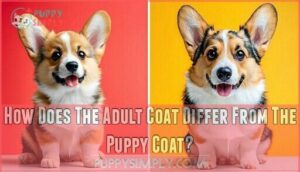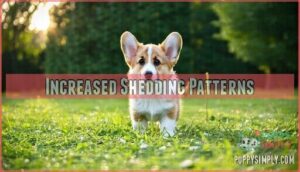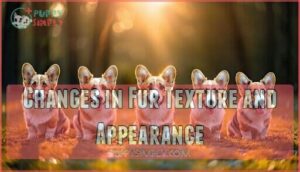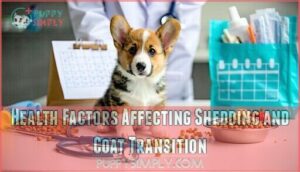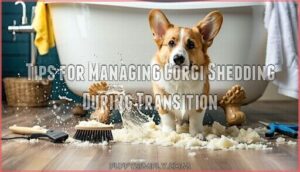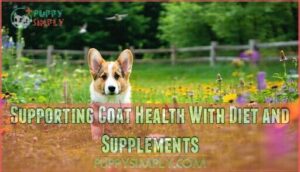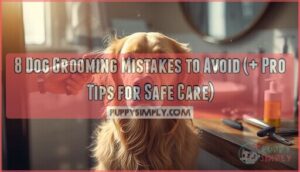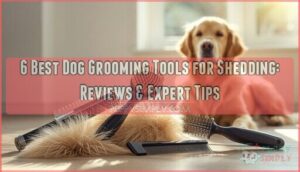This site is supported by our readers. We may earn a commission, at no cost to you, if you purchase through links.

What’s happening here is your pup’s hormones are kicking in, swapping out that baby-soft fluff for a tougher, thicker adult coat that’ll actually keep them warm and dry.
During this changeover, you’ll see way more fur around the house, the texture getting rougher, and maybe even some slight color changes.
Factors like nutrition, stress, and genetics can influence the timing and intensity of the process, making each pup’s timeline unique in their coat transformation journey.
Table Of Contents
- Key Takeaways
- When Do Corgis Shed Their Puppy Coats?
- What Triggers The Shedding Process in Corgis?
- How Does The Adult Coat Differ From The Puppy Coat?
- Signs Your Corgi is Transitioning to an Adult Coat
- Health Factors Affecting Shedding and Coat Transition
- Tips for Managing Corgi Shedding During Transition
- Supporting Coat Health With Diet and Supplements
- Frequently Asked Questions (FAQs)
- Conclusion
Key Takeaways
- Most corgis shed their puppy coat between 6-12 months, with peak shedding typically happening around 7 months old, though some start as early as 14 weeks or as late as 13 months.
- You’ll notice increased shedding and texture changes as your corgi’s soft, fluffy puppy fur transforms into a coarser, denser adult double-coat that’s better for weather protection.
- Daily brushing with proper tools becomes essential during this transition period to manage the avalanche of fur and prevent matting while supporting your pup’s developing adult coat.
- Good nutrition and stress management can influence the timing – factors like poor diet, allergies, or anxiety can delay normal development or cause excessive shedding during this natural process.
When Do Corgis Shed Their Puppy Coats?
You’ll notice your corgi’s fluffy puppy coat starting to shed between 6 and 12 months of age, though some pups begin as early as 14 weeks.
This natural process marks the shift to their adult double coat, which will be coarser and denser than that adorable baby fuzz.
Typical Shedding Timeline (6-12 Months)
Your Corgi will start trading their puppy fluff for adult fur somewhere between six and twelve months. You’ll see this happen gradually during those early growth months – the shedding gets pretty noticeable as their new double coat comes in.
Expect things to really ramp up around seven months. That’s when the shedding hits its peak and you’ll find yourself vacuuming more often. It’s all normal though – just your pup’s coat making the switch from baby-soft fur to that thick, weather-resistant double layer adult Corgis are known for.
Early and Late Shedding Variations
Most pups shed between 6-12 months, but plenty of corgis don’t follow this timeline. Some start losing that puppy fluff as early as 12 weeks—usually because of their genes or things like longer daylight hours triggering the change.
Others hang onto their baby coats until 13 months or so, particularly if they’re not getting proper nutrition or their coat just develops more slowly than average.
Individual puppy differences mean your corgi’s shedding start age varies notably. Understanding dog shedding patterns is vital for corgi owners to manage their pet’s coat health effectively.
What Triggers The Shedding Process in Corgis?
Your Corgi’s shedding process kicks into gear when hormonal changes signal it’s time to develop that thick adult coat, typically triggered by natural growth cycles between 6-12 months.
Sure, things like temperature changes and how much daylight your Corgi gets matter too, but honestly? Most of this coat transformation happens because of what’s going on inside your dog’s body.
Role of Seasonal Changes
Throughout the year, seasonal changes drive your Corgi’s shedding patterns through photoperiod changes and temperature effects.
Spring and fall trigger heavy seasonal shedding as their coat adaptation reacts to shifting daylight hours. Humidity impact and temperature fluctuations signal your pup’s body to shed winter or summer fur, preparing for upcoming seasons.
Hormonal and Developmental Factors
Your Corgi’s hormones don’t just influence behavior—they’re the puppet masters behind that coat transformation. When those puppy growth hormones start tapering off around six months, they flip a biological switch that kicks the double coat development into high gear. This hormonal shift sets up those infamous shedding seasons you’ll soon know by heart.
Your Corgi’s hormones flip a biological switch around six months, kicking double coat development into high gear
- Growth hormone drops signal the end of puppy fur softness
- Thyroid function directly impacts how quickly new adult fur develops
- Stress hormones can accelerate or delay normal Corgi shedding patterns
Health factors like poor nutrition or anxiety can disrupt this natural process.
How Does The Adult Coat Differ From The Puppy Coat?
You’ll notice the transformation from fluffy puppy fur to a coarser, denser adult coat that’s built for weather protection.
The adult coat develops a more defined double-layer system with a thicker undercoat and guard hairs that may shift slightly in color or pattern from your corgi’s original puppy appearance.
Texture and Thickness Changes
When you run your hand through an adult dog’s coat, the difference from that baby-soft puppy fluff is unmistakable. The fur grows thicker and rougher as those hair follicles do their thing over time.
What really changes everything is how the double coat comes together—you’ve got that packed-in undercoat working with the longer guard hairs on top, so your fingers pick up all these different textures in one stroke.
| Characteristic | Puppy Coat | Adult Coat |
|---|---|---|
| Texture | Soft, fluffy | Coarser, denser |
| Coat Length | Shorter, uniform | Variable lengths |
| Shedding Patterns | Minimal | Heavy, seasonal |
Color and Pattern Shifts
As your Corgi transitions from puppy to adult coat, you’ll notice fascinating coat color genetics at work. The double coat often reveals deeper, richer hues while some patterns fade or intensify. Masking effects may alter facial markings markedly.
- Fading factors diminish bright puppy colors into muted adult tones
- Ticking influence creates speckled patterns where none existed before
- Pattern variations shift sable markings and white distribution across the undercoat
These changes happen gradually during shedding seasons, making coat maintenance essential for monitoring your pup’s transformation.
Signs Your Corgi is Transitioning to an Adult Coat
You’ll notice your Corgi’s shedding increases dramatically as loose puppy fur gives way to coarser adult hair, often creating tumbleweeds of fluff around your home.
The new coat feels denser and rougher to the touch, while colors may deepen or shift as the mature double-layer develops.
Increased Shedding Patterns
How do you know your Corgi’s changing? You’ll notice their shedding patterns shift dramatically. Double coats create intense seasonal shed cycles, with hair growth accelerating during spring and fall.
Your Corgi’s shedding seasons become more pronounced as coat thickness increases. These changing shedding patterns signal their puppy fur’s giving way to dense adult double coats.
Changes in Fur Texture and Appearance
Your dog’s coat texture becomes noticeably coarser as the soft puppy fur gives way to adult double coat development. The fur density increases markedly, while coat length may vary depending on your corgi’s genetics.
You’ll notice texture changes from fluffy to weather-resistant, with color variations sometimes appearing. These shedding patterns indicate your corgi’s undercoat and outer coat are maturing properly.
Health Factors Affecting Shedding and Coat Transition
Health problems can throw off your corgi’s normal coat transition timeline. Things like poor nutrition, allergies, or stress might delay when they lose their puppy fluff or cause them to shed way more than usual during this stage.
Poor nutrition, allergies, or stress can delay normal development or cause excessive shedding during this vital period.
Nutritional Deficiencies Possible
Although nutritional deficiencies are uncommon with commercial dog food, they can trigger excessive corgi shedding during coat transitions. Poor diets lacking protein, zinc, or essential fatty acids affect 14% of dogs with unexplained hair loss.
Homemade diets pose the highest risk, causing visible coat deterioration in over 50% of corgis within twelve months without proper mineral supplements and balanced nutrition.
Providing a balanced dog diet is vital for maintaining healthy skin and coat in corgis.
Allergies Can Exacerbate Shedding
Beyond diet, allergies can turn normal shedding into a frustrating hair storm. Food sensitivities, environmental triggers like pollen, or contact allergens create skin irritation that makes your Corgi scratch constantly. This scratching damages coat health and accelerates shedding patterns far beyond what’s typical for the breed.
- Food allergies often cause excessive scratching and patchy hair loss
- Environmental allergens like dust mites trigger year-round skin reactions
- Contact allergies from shampoos or fabrics create localized shedding spikes
- Allergic reactions compromise skin health, making fur fall out more easily
Stress Impacts Shedding Too
Your Corgi’s stress levels directly affect shedding patterns. Anxiety from changes like moving, new pets, or loud noises can trigger excessive hair loss beyond normal seasonal cycles.
Calming aids like pheromone diffusers, anxiety wraps, or relaxation techniques help manage stress-induced shedding.
Creating consistent routines and providing emotional assistance reduces anxiety, keeping your Corgi’s coat healthier during transitions.
Tips for Managing Corgi Shedding During Transition
You’ll face an avalanche of fur during your corgi’s coat shift, but the right grooming approach makes this phase manageable.
Daily brushing with proper tools and consistent bathing schedules will help you stay ahead of the shedding while supporting your pup’s developing adult coat.
Recommended Grooming Tools and Techniques
Managing Corgi shedding becomes simpler with the right grooming arsenal. A slicker brush works wonders for daily brushing, while a quality deshedder handles stubborn undercoat hair effectively. Wire brushes help prevent matting during heavy shedding periods.
Establish consistent grooming frequency—daily brushing during coat transitions prevents fur tumbleweeds from taking over your home. These shedding tools make coat maintenance manageable and keep your corgi comfortable.
Importance of Regular Brushing and Bathing
Consistency becomes your secret weapon during your corgi’s coat shift. Daily brushing with proper grooming tools prevents matting while removing loose fur before it lands on furniture.
Weekly bathing frequency maintains coat conditioning and skin health. These brushing techniques reduce corgi shedding markedly, making coat maintenance manageable during this natural shedding process.
Supporting Coat Health With Diet and Supplements
You can’t build a healthy adult coat from the inside out without the right nutritional foundation, especially during your corgi’s critical growth period between 6-12 months.
The right combination of omega fatty acids, high-quality proteins, and targeted supplements will promote stronger hair follicles and reduce excessive shedding as your pup develops their dense double coat.
Key Nutrients for Healthy Fur
Your Corgi’s diet directly impacts how their coat handles seasonal shedding. Quality protein from chicken and fish gives their fur the building blocks it needs, while omega-3s keep things shiny and cut down on skin irritation.
Getting the right vitamins—think biotin and zinc—keeps new fur growing strong. Good fiber helps their body actually use these nutrients, and sometimes a mineral boost can fix deficiencies that make shedding worse.
Product Recommendations for Corgi Owners
When choosing shedding tools and grooming equipment, invest in a quality slicker brush for daily maintenance and a deshedding tool for heavy shed periods.
Pet vacuums designed for dog hair make cleanup easier.
Consider coat supplements with omega fatty acids to sustain healthy fur growth during your corgi’s shifting phase.
Frequently Asked Questions (FAQs)
What factors or events trigger the shedding process in Corgis?
Your Corgi sheds for several reasons. Seasonal changes trigger the biggest waves of fur loss, usually in spring and fall.
Hormonal shifts during heat cycles or pregnancy also ramp up shedding. Stress can make them lose more hair than usual.
Poor diet lacking proper nutrients weakens their coat. Allergies to food or environmental triggers cause excessive shedding too.
Parasites like fleas or mites irritate the skin and make hair fall out more easily.
Can spaying affect puppy coat shedding timing?
Yes, spaying can slightly delay your Corgi’s coat change. Hormonal changes from the procedure may push back shedding by a few weeks to months beyond the typical 6-12 month timeline.
Do male and female corgis shed differently?
Gender doesn’t dramatically alter shedding patterns in Corgis. However, females may experience slightly heavier seasonal shedding during heat cycles or after pregnancy due to hormonal fluctuations.
What if my corgi never sheds puppy fur?
Some Corgis retain their puppy coat longer than expected. This isn’t necessarily concerning unless they’re over 18 months old. Consult your vet if you’re worried about delayed coat development.
Should I trim during coat transition period?
Walking on thin ice here—resist trimming during your corgi’s coat change.
The changing fur needs time to naturally shed and regrow. Trimming can disrupt this process, potentially causing uneven growth patterns or skin irritation issues.
Do mixed corgi breeds follow same timeline?
Mixed breed corgis generally follow similar timelines, usually shedding puppy coats between 6-12 months. However, the other parent breed’s genetics can influence timing and coat characteristics considerably.
Conclusion
Remember, patience is a virtue – your Corgi’s journey from puppy fluff to adult coat is unique. Most Corgis shed their puppy coats between 6-12 months, but don’t worry if your pup’s timeline differs.
Assist them with proper nutrition, regular brushing, and stress management during this natural shift. Understanding when Corgis shed their puppy coats helps you prepare for increased grooming needs and celebrate your dog’s beautiful adult double-coat development.
- https://www.reddit.com/r/corgi/comments/rs5uc4/when_do_corgis_grow_their_full_coat_my_12weekold/
- https://www.akc.org/expert-advice/health/why-puppies-shed/
- https://a-z-animals.com/blog/corgi-progression-growth-chart-milestones-and-training-tips/
- https://www.purina.com/dogs/dog-breeds/pembroke-welsh-corgi
- https://nativepet.com/blogs/health/do-corgis-shed




